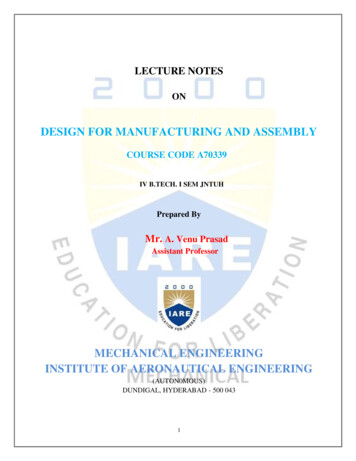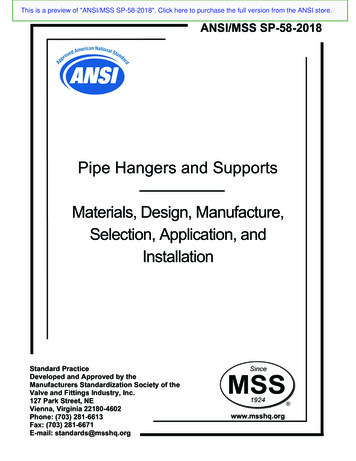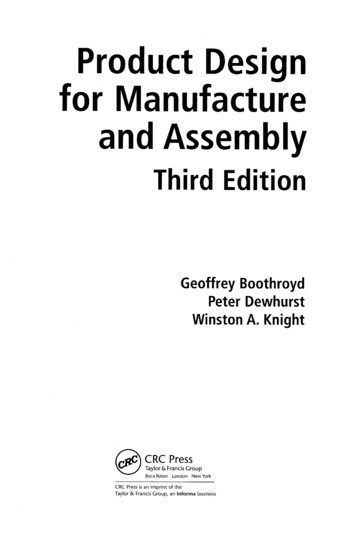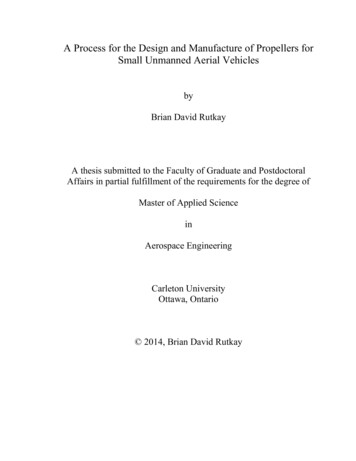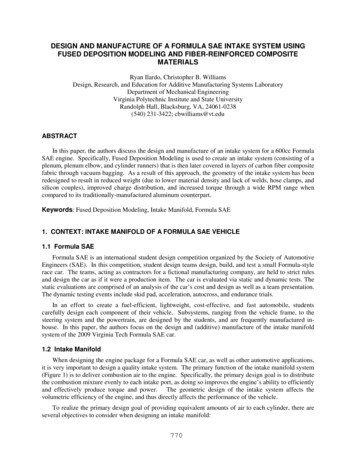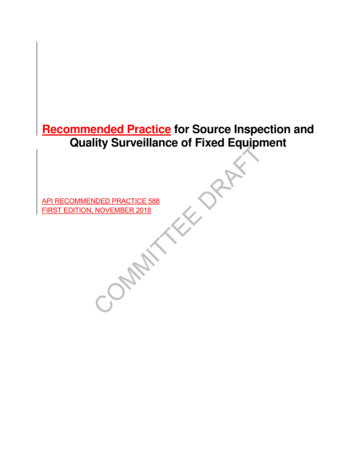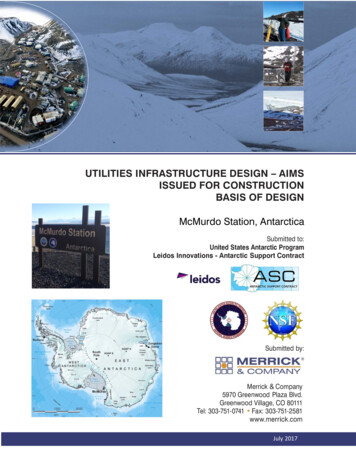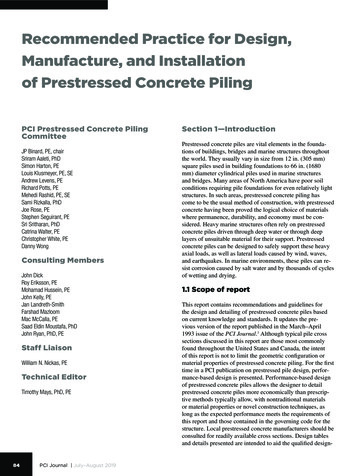
Transcription
Recommended Practice for Design,Manufacture, and Installationof Prestressed Concrete PilingPCI Prestressed Concrete PilingCommitteeJP Binard, PE, chairSriram Aaleti, PhDSimon Harton, PELouis Klusmeyer, PE, SEAndrew Levens, PERichard Potts, PEMehedi Rashid, PE, SESami Rizkalla, PhDJoe Rose, PEStephen Seguirant, PESri Sritharan, PhDCatrina Walter, PEChristopher White, PEDanny WongConsulting MembersJohn DickRoy Eriksson, PEMohamad Hussein, PEJohn Kelly, PEJan Landreth-SmithFarshad MazloomMac McCalla, PESaad Eldin Moustafa, PhDJohn Ryan, PhD, PEStaff LiaisonWilliam N. Nickas, PETechnical EditorTimothy Mays, PhD, PE84PCI Journal July–August 2019Section 1—IntroductionPrestressed concrete piles are vital elements in the foundations of buildings, bridges and marine structures throughoutthe world. They usually vary in size from 12 in. (305 mm)square piles used in building foundations to 66 in. (1680mm) diameter cylindrical piles used in marine structuresand bridges. Many areas of North America have poor soilconditions requiring pile foundations for even relatively lightstructures. In such areas, prestressed concrete piling hascome to be the usual method of construction, with prestressedconcrete having been proved the logical choice of materialswhere permanence, durability, and economy must be considered. Heavy marine structures often rely on prestressedconcrete piles driven through deep water or through deeplayers of unsuitable material for their support. Prestressedconcrete piles can be designed to safely support these heavyaxial loads, as well as lateral loads caused by wind, waves,and earthquakes. In marine environments, these piles can resist corrosion caused by salt water and by thousands of cyclesof wetting and drying.1.1 Scope of reportThis report contains recommendations and guidelines forthe design and detailing of prestressed concrete piles basedon current knowledge and standards. It updates the previous version of the report published in the March–April1993 issue of the PCI Journal.1 Although typical pile crosssections discussed in this report are those most commonlyfound throughout the United States and Canada, the intentof this report is not to limit the geometric configuration ormaterial properties of prestressed concrete piling. For the firsttime in a PCI publication on prestressed pile design, performance-based design is presented. Performance-based designof prestressed concrete piles allows the designer to detailprestressed concrete piles more economically than prescriptive methods typically allow, with nontraditional materialsor material properties or novel construction techniques, aslong as the expected performance meets the requirements ofthis report and those contained in the governing code for thestructure. Local prestressed concrete manufacturers should beconsulted for readily available cross sections. Design tablesand details presented are intended to aid the qualified design-
er. Actual design details, including the selection of materials,pile sizes, and pile shapes, should conform to local practicesand code requirements.ASTM A572, Standard Specification for High-StrengthLow-Alloy Columbium-Vanadium Structural Steel1.1.1 Materials Section 2 discusses cements, aggregates,ASTM A615, Standard Specification for Deformed and PlainCarbon-Steel Bars for Concrete Reinforcementwater, admixtures, and reinforcement. Recommendations aremade regarding these constituents and their effects on the quality and strength of concrete.ASTM A706, Standard Specification for Deformed and PlainLow-Alloy Steel Bars for Concrete Reinforcement1.1.2 Design Section 3 begins with a discussion of variousfactors that should be considered in the design of prestressedconcrete piles and pile foundations. Prescriptive and performance-based design provisions are presented in detail withreference to how they should be used in conjunction withgoverning codes and standards. Although some design aids areprovided, reference is made to PCI’s free software program(PCI PD-01) for developing axial-moment interaction diagrams for the ultimate capacity of commonly used pile sizes ofvarying concrete strengths and effective prestress levels.Good design practice requires clear communication betweenthe project engineer of record, the project geotechnical engineer, and, when applicable, the specialty engineer responsiblefor the design of the prestressed concrete piling.ASTM A722, Standard Specification for High-Strength SteelBars for Prestressed ConcreteASTM A882, Standard Specification for Filled Epoxy-CoatedSeven-Wire Prestressing Steel StrandASTM A884, Standard Specification for Epoxy-Coated SteelWire and Welded Wire ReinforcementASTM A1060, Standard Specification for Zinc-Coated(Galvanized) Steel Welded Wire Reinforcement, Plain andDeformed, for ConcreteASTM A1064, Standard Specification for Carbon-Steel Wireand Welded Wire Reinforcement, Plain and Deformed, forConcrete1.1.3 Manufacture and transportation Section 4 coversspecial requirements involved in the manufacture, handling,transportation, and tolerances for prestressed concrete piles.ASTM C31, Standard Practice for Making and Curing Concrete Test Specimens in the Field1.1.4 Installation The purpose of section 5 is to set forthASTM C33, Standard Specification for Concrete Aggregatesgeneral principles for proper prestressed concrete pile installation. Discussion of handling- and driving-induced compression, tension, bending, and torsion provides a basis forrecommendations to prevent damage to prestressed concretepiles. Techniques related to the cutting or occasional extensionof piles are suggested.ASTM C39, Standard Test Method for Compressive Strengthof Cylindrical Concrete SpecimensASTM C143, Standard Test Method for Slump of HydraulicCement Concrete1.1.5 Current research and future applications forprestressed concrete piling Section 6 concludes thisASTM C150, Standard Specification for Portland Cementreport by highlighting some of the current issues and futureresearch needs involving the design, manufacture, and installation of prestressed concrete piles. A state of practice overview ofmitigating and monitoring the effects of pile-driving vibrationsis included. Current pile-related research showing great promiseis mentioned and future research needs are also examined.ASTM C172, Standard Practice for Sampling Freshly MixedConcrete1.2 Standards and references1.2.1 ASTM standardsASTM A29, Standard Specification for General Requirementsfor Steel Bars, Carbon and Alloy, Hot-WroughtASTM A416, Standard Specification for Low-Relaxation,Seven-Wire Steel Strand for Prestressed ConcreteASTM A421, Standard Specification for Stress-Relieved SteelWire for Prestressed ConcreteASTM C260, Standard Specification for Air-EntrainingAdmixtures for ConcreteASTM C330, Standard Specification for Lightweight Aggregates for Structural ConcreteASTM C494, Standard Specification for Chemical Admixturesfor ConcreteASTM C595, Standard Specification for Blended HydraulicCementsASTM C618, Standard Specification for Coal Fly Ash andRaw or Calcined Natural Pozzolan for Use in ConcreteASTM C989, Standard Specification for Slag Cement for UsePCI Journal July–August 201985
in Concrete and MortarsASTM C1107, Standard Specification for Packaged Dry,Hydraulic-Cement Grout (Nonshrink)ASTM C1157, Standard Performance Specification for Hydraulic CementASTM C1240, Standard Specification for Silica Fume Usedin Cementitious MixturesPCI MNL-137, Manual for the Evaluation and Repair ofPrecast, Prestressed Concrete Bridge ProductsPCI PD-01, Calculation of Interaction Diagrams for Precast,Prestressed PilesPCI STD-112, Standard Prestressed Concrete PilesPCI STD-113, Prestressed Concrete Sheetpiles1.2.4 American Welding Society (AWS) standardsASTM C1260, Standard Test Method for Potential AlkaliReactivity of Aggregates (Mortar-Bar Method)ASTM C1602, Standard Specification for Mixing Water Usedin the Production of Hydraulic Cement ConcreteASTM C1611, Standard Test Method for Slump Flow ofSelf-Consolidating ConcreteASTM C1778, Standard Guide for Reducing the Risk of Deleterious Alkali-Aggregate Reaction in ConcreteASTM D1143, Standard Test Methods for Deep FoundationsUnder Static Axial Compressive LoadASTM D3689, Standard Test Methods for Deep FoundationsUnder Static Axial Tensile LoadASTM D3966, Standard Test Methods for Deep FoundationsUnder Lateral LoadASTM D4945, Standard Test Method for High-Strain Dynamic Testing of Deep FoundationsASTM D7383, Standard Test Methods for Axial CompressiveForce Pulse (Rapid) Testing of Deep Foundations1.2.2 American Concrete Institute (ACI) standardsand guidesACI 201.2R, Guide to Durable ConcreteACI 318, Building Code Requirements for Structural Concrete and CommentaryACI 543R, Guide to Design, Manufacture, and Installation ofConcrete Piles1.2.3 PCI standards and referencesPCI MNL-116, Manual for Quality Control for Plants andProduction of Structural Precast Concrete ProductsPCI MNL-120, PCI Design Handbook: Precast and Prestressed ConcretePCI MNL-133, PCI Bridge Design Manual86PCI Journal July–August 2019AWS D1.1, Structural Welding Code – SteelAWS D1.4, Structural Welding Code – Reinforcing Steel1.2.5 Post-Tensioning Institute (PTI)ReferencesPTI M55.1, Specification for Grouting of Post-TensionedStructuresSection 2—MaterialsMaterial properties and requirements for prestressedconcrete piles are almost identical to those for all precast,prestressed concrete structural members. Piles, however, aresubject to long-term contact with soil and moisture as wellas submergence in water and other aggressive environments.Therefore, the in-service conditions require that materials used in piles be carefully selected to reduce long-termdurability issues such as corrosion, alkali-silica reaction, anddelayed ettringite formation. Special consideration shouldbe given to using appropriate materials that ensure satisfactory short- and long-term performance of the piling. Onany project, in addition to satisfying the recommendationsprovided in this report, designers must also consider localor state specifications governing the use and availability ofcertain products or materials used to construct prestressedconcrete piles. This section provides a detailed discussionregarding material constituents of concrete. Before castingprestressed concrete piles, the mixture proportions for theconcrete should be submitted to the engineer or owner forreview and approval.2.1 Cementitious materialsPortland cement conforming to ASTM C150 Types I, II, III,or V is commonly used in prestressed concrete piling. Blended and performance-based cements conforming to ASTMC595 and ASTM C1157 may also be used in prestressed concrete piling. Selection of the appropriate cement type and other constituents for a particular project should be based on theexposure conditions to which the piles will be subjected andlocal experience in these conditions, in addition to strength,strength gain, and workability requirements. Type III (or highearly strength) cement is often used for piles to facilitate rapidreuse of the formwork.
In areas of moderate exposure to sulfate-containing soils(soils containing 0.10% to 0.20% of water-soluble sulfate byweight) or sulfate-containing waters (seawater or waters containing 150 to 1500 ppm dissolved sulfate), the tricalcium aluminate (C3A) content of the cement should be limited to 8%(ACI 318-14).2 Note that seawater is explicitly listed underExposure Class S1 with the acknowledgment that water-soluble-sulfate concentration may exceed 1500 ppm dissolvedsulfate. For areas of severe sulfate exposure, ACI 318 recommends a 5% limit on C3A for concentrations over 0.20% forsoils or 1500 ppm for waters (note that Exposure Class S2 hasupper bound concentrations of 2.00% of water-soluble sulfateand 10,000 ppm for waters). However, for higher-strengthconcretes (6000 psi [41.4 MPa] and greater) employed in themanufacture of prestressed concrete piles, the 8% limit onC3A is considered adequate for sulfate concentrations over0.20%. See ACI 543R-123 for more information. When usingblended cements, MS- and HS-designated cements shouldbe used in moderate sulfate (MS) exposures and high sulfate (HS) exposures, respectively. It is suggested that localprestressed concrete manufacturers be consulted for readilyavailable cements, as special cement requirements will affectcost and performance.Cements meeting the sulfate requirements presented previously are classified respectively as Type II (providing moderate sulfate resistance) and Type V (providing high sulfateresistance). A number of Type III cements also meet theserequirements. Blended hydraulic cements meeting ASTMC595 or hydraulic cements complying with the performancerequirements of ASTM C1157 are classified as either MS- orHS-resisting based on results from an ASTM C1012 test. Alternative combinations of cementitious materials may be usedif tests for sulfate resistance demonstrate satisfactory performance in ASTM C1012 testing. Type V cement may not bereadily available in all parts of the country, in which case ACI543R-123 and some state highway specifications recommendsubstitution of Type II cement combined with Class F fly ash.For the higher-strength concretes used with prestressed concrete piles, the use of Type V cement may not be absolutelynecessary, even for severe sulfate exposure conditions, unlessrequired by the governing code for the structure.For prestressed concrete piles exposed to seawater, tests showthat concrete made with cement containing 5% to 8% C3Aexhibits less cracking because of steel reinforcement corrosion than concretes made with cement with less than 5%C3A.4 Although cements with these lower C3A contents (TypeV) provide increased sulfate resistance, they tend to increasethe risk of steel corrosion (chloride exposure). It is thereforerecommended that Type V cement not be used for piles inseawater or other high-chloride environments.Fly ash (ASTM C618), slag cement (ASTM C989), silicafume (ASTM C1240), or pozzolanic materials (ASTM C618)may be combined with cement to enhance certain characteristics of concrete. Although these supplementary cementitious materials are often combined with cement to producehigher compressive strengths, their use in piles is primarily toincrease the long-term durability of concrete. When combinedin the proper proportions, the result is generally a denser, lessporous concrete with greater resistance to chloride and sulfatepenetration. Many local and state specifications have requirements for their use under certain exposure conditions or limittheir proportions relative to the total cementitious materialcontent. Blended cements, when used, should conform toASTM C595.2.2 AggregatesFine and coarse aggregates should conform to ASTM C33.Although not commonly used, lightweight aggregates shouldconform to ASTM C330. Aggregates failing to meet thesespecifications, but which have been shown by special testsor actual service to produce concrete of adequate strengthand durability, may be used with approval of the governingauthority. Aggregates susceptible to alkali-aggregate reactivity(AAR) are not recommended for use in prestressed concretepiles; if they are used, special precautions must be observed.ASTM C1778 can be used to address potential AAR concerns.Testing for alkali reactivity of aggregates should be performedin accordance with guidance given in ASTM C1778-16.Special attention should be paid to the type, distribution, andmaximum size of aggregate to promote proper mixing andconsolidation, particularly for concrete containing pozzolanicmaterials and those used with closely spaced transverse reinforcement (for example, for seismic applications).2.3 WaterWater used for washing aggregates, mixing concrete, orcuring concrete must be clean and free of oil, salt, acid, alkali,and deleterious substances. Water of potable quality is recommended but not required. Mixing water for concrete shouldconform to ASTM C1602 and should not contain a chlorideion concentration more than 500 ppm or sulfates in the formof SO4 in excess of 1300 ppm.2.4 AdmixturesAll admixtures used in concrete piling must be compatiblewith each other and with the cement being used. Certaincombinations of admixtures may further improve handling,placement, finishing, and performance characteristics of theconcrete. A brief discussion of admixtures used for prestressed concrete piles follows.Air-entrained concrete may be used in piles that will besubjected to cycles of freezing and thawing or wetting anddrying. Air-entraining admixtures conforming to ASTM C260should be used where concrete piles are exposed to these conditions. The amount of air entrainment and its effectivenessdepend on the admixture used, the size and type of the coarseaggregate, the moisture content of the aggregate, and othervariables. Too much air will lower the strength of the concreteand too little will reduce its effectiveness. It is recommendedPCI Journal July–August 201987
that the air content of the concrete be less than 7% by volume,depending on the size of the coarse aggregate and the severityof exposure. It is important to note that air-entraining admixtures are typically not considered effective for prestressedhigh-strength concrete piling applications, due to the highdensity and low porosity associated with high-strength concrete. Using air entrainment in high-performance concretes,and other mixtures using pozzolanic or nonpozzolanic materials for durability considerations, normally will not increasefreezing and thawing resistance significantly. In some cases,however, air-entraining admixtures may be used to improveconcrete workability, especially for piles with very closelyspaced transverse reinforcement. Overall, site conditionsshould be evaluated against the quality of the concrete beforespecifying air entrainment.2.6 Steel reinforcementWhen approved by the engineer, shrinkage-reducing admixtures can be used to reduce prestress losses due to concreteshrinkage.Prestressed concrete piles are typically produced usingseven-wire strand conforming to ASTM A416 for longitudinal prestressing, wire spiral conforming to ASTM A1064for transverse reinforcement, and deformed reinforcementconforming to ASTM A615 or ASTM A706, typically usedfor connection detailing. Strand sizes range from 3 8 in.(9.5 mm) to 0.6 in. (15.2 mm) diameter, with ½ in. (12.7 mm)diameter being a commonly used size in piles. Although notcommonly used, epoxy-coated prestressing strand conforming to ASTM A882 and epoxy-coated wire conforming toASTM A884 for spiral reinforcement can be specified. Wirefor spiral reinforcement typically has higher yield strengththan typical nonprestressed reinforcement, with yieldstrengths up to 100 ksi (690 MPa). Galvanized strand anddeformed reinforcing bars as well as stainless-steel strand andreinforcing bars are also design options but are rarely specified for use in prestressed concrete piles. Some agencies dorequire the use of galvanized wire (ASTM A1060). The useof both galvanized and nongalvanized steel in a pile may notbe a good idea. Although pile-driving conditions necessitatesymmetrically placed spiral reinforcement and smaller spiralpitch at the ends of a pile, nonsymmetrical spiral reinforcement may be desired any time large shear forces or seismicconfinement requirements exist along a designated length ofthe pile. For these reasons, special consideration should begiven in these instances to mark the pile ends (top and bottom) so that the pile is installed in its correct orientation.2.5 Concrete strength2.7 Structural steelFor prestressed concrete piles, the minimum concrete strengthat the time of prestress transfer f ci' should be 3500 psi(24.1 MPa). Concrete in precast, prestressed concrete pilesand build-ups should have a minimum compressive strengthf c' of 5000 psi (34.5 MPa) at 28 days. Pile design, handlingconfigurations, and some agencies may require higher minimum concrete strengths at transfer and at 28 days. Economy in handling and driving along with higher load capacitycan be achieved with concrete strengths up to 10,000 psi(68.9 MPa). Designers should check with local pile manufacturers to determine attainable strengths.For exceptionally hard pile-driving conditions, particularlyfor bearing on rock or penetration through hard strata, specialtreatment of the pile tip may be advantageous. This may takethe form of added spiral or other reinforcement at the tip,steel shoes, or points. In some cases, a structural steel H-pileis used to provide a permanent, load-bearing structural tip,commonly called a stinger, on the end of a prestressed concrete pile. This material must withstand driving, so it shouldmeet the requirements for steel H-pile sections (ASTM A572Grade 50). The thickness of any steel in a pile tip should notbe less than 3 8 in. (9.53 mm).For the sake of durability, concrete piles should have a minimum cementitious material content of 564 lb/yd3 (335 kg/m3)of concrete. The water–cementitious material ratio (byweight) should correspond to the least amount of waterThe suitability of the steel for welding should be predetermined because some producers prefer to cast the piles withjust an embedded plate or only a short portion of the tip extending outside the pile. This preserves the casting capacity ofWhen used, water-reducing admixtures (including those forself-consolidating concrete), retarding admixtures, accelerating admixtures, water-reducing and retarding admixtures, andwater-reducing and accelerating admixtures should conform toASTM C494. Calcium chloride or admixtures containing calcium chloride should not be used. Water-reducing admixturesare sometimes required when significant percentages of silicafume or pozzolanic materials are used in the concrete, and theimproved workability due to their use is especially beneficialfor piles with closely spaced transverse reinforcement.Corrosion inhibitors, such as calcium nitrite, may be specifiedwhen concrete piles will be exposed to seawater, or in otherapplications where the potential for chloride attack is high. Theuse of calcium nitrite may affect the workability and settingcharacteristics of the concrete, so it is important to adjust themixture proportions to account for these effects. The use ofhigh-performance, high-strength concrete, with decreased permeability, may make it unnecessary to use corrosion inhibitors.88that will produce a plastic mixture and provide the desiredworkability for the most effective placement of the concrete.Maximum water–cementitious material ratios are typicallybased on exposure. In aggressive environments, such as formarine applications or for sites with high chloride or highsulfate exposure, a minimum cementitious material content of658 lb/yd3 (390 kg/m3) is recommended. See ACI 201.2R-084for durability recommendations where pozzolans and fly ash(ASTM C618) are used.PCI Journal July–August 2019
the bed and simplifies the precast-concrete-pile portion of thefabrication. The remainder of the specified length of the tip isthen welded onto the plate or the protruding portion after thepile is removed from the bed.Headed steel studs (conforming to ASTM A29) on each side ofthe web in the embedded portion of the steel stinger or deformed bar anchors, with or without a stinger plate, may be required in some cases for the anchorage of the embedded portionof the steel tip into the pile. The use and installation of headedsteel studs should conform to the requirement of AWS D1.1.2.8 GroutThe need for grout in prestressed concrete piles is not common, and is generally limited to the grouting of dowels in pileheads or the bonding and protection of prestressing strandsused to join sections of cylinder piles. The former applicationinvolves piles that are field-spliced with dowels in oversizedholes or to provide pile-to-pile cap connections using grouteddowels. The latter case is common with large-diameter hollowcylinder piles available in several regions of the country.Cement grout, where used in prestressed concrete piles,should conform to ASTM C1107 and comprise materials thatconform to the requirements stipulated herein for cement,sand, admixtures, and water. Approved expanding admixturesor expansive cements may be used. Some expanding admixtures contain calcium chloride and should not be used. Neatcement grout is frequently used to grout dowels in pile heads.PTI M55.1-12, Specification for Grouting of Post-TensionedStructures, should be consulted for information regardinggrouting of prestressing tendons when designing segmentedprestressed concrete piles. Epoxy grout may also be used insome applications.the ultimate frictional resistance of the soil along the sidesof the pile and the resistance of the bearing strata underneaththe pile tip. The sum of these two resistance mechanisms isreferred to as the ultimate bearing capacity of the pile. In mostcases, the ultimate bearing capacity of the pile is calculated tobe less than the structural strength of the pile as determinedusing the methods presented in this section. The failure of anindividual pile or a pile group in tension can occur when theapplied load on the pile exceeds just the ultimate frictionalresistance of the soil along the sides of the pile.3.1.1 Load capacity of individual piles: preliminarydesign considerations During the preliminary designphase of any project, the project geotechnical engineer or engineer of record should make recommendations concerning piletype, pile size, drivability, test pile locations, and the need forstatic or dynamic testing.Before installation, the project geotechnical engineer orengineer of record should review pile shop drawings in conjunction with the pile driver’s proposed installation method,including hammer size, to ensure that the hammer used duringinstallation and the proposed installation method are consistent with pile’s properties, which include size, strength, andweight, and with the soil conditions of the site.During construction, the project geotechnical engineer orengineer of record should be involved in pile testing operations, the interpretation of test results, and the evaluation ofproduction pile-driving observations. In conjunction withthe engineer of record, the geotechnical engineer should beprepared to modify the design, where necessary, based on theresulting test data and construction observations. Changes topile lengths and project driving operations in the field shouldbe anticipated.2.9 Anchorages3.1.2 Load capacity of individual piles: compression Consistent with standard practice for lightly loadedAnchorage fittings for post-tensioning assemblies should conform to the requirements of ACI 318-14, section 25.8.2building pile applications, this document permits the use ofpile installations without the added expense of load testingwhen the allowable compressive axial load for the pile doesnot exceed 40 tons (356 kN). In such cases, approved driving formulas are sufficient for specifying a pile’s allowableload. It should be noted that pile-driving formulas have neverreally been considered accurate and they are based on severalassumptions that may be unconservative.5 Furthermore, piledimensions, allowable pile loads, and pile-driving-hammerrated energies have increased substantially over recent years,making the use of pile-driving formulas even less applicable.Section 3—DesignThis section covers important design considerations and presents design aids for prestressed concrete piling. Load-capacitydetermination procedures, structural design and detailing procedures, and special considerations for compression, tension,flexure, shear, and combined actions are discussed. Detailedprovisions for prescriptive- and performance-based design areincluded, and reference is made to PCI’s free software program for developing axial-moment interaction diagrams forthe ultimate capacity of commonly used pile sizes of varyingconcrete strengths and effective prestress levels.3.1 Load capacity of individual pilesThe failure of an individual pile or a pile group in compression can occur when the applied load on the pile exceeds bothFor allowable compressive axial loads greater than 40 tons(356 kN), wave equation analysis may be used in conjunction with load tests (for some small percentage of piles, asdiscussed in section 3.1.5) to the degree deemed necessaryby the project geotechnical engineer or engineer of record toestimate driving conditions and to determine the appropriateallowable compressive load for the pile, respectively. Unlikepile-driving formulas, wave equation analysis includes aPCI Journal July–August 201989
realistic model of important parameters such as pile, soil, andhammer characteristics.Allowable compressive axial loads are most commonlydetermined from load tests. Static (ASTM D1143), rapid(ASTM D7383), and dynamic (ASTM D4945) procedures arepermitted. Dynamic testing is a real-time blow-by-blow evaluation of the pile’s capacity, hammer energy transfer, internalstresses, and pile integrity. The allowable axial load is determined using the data obtained at the end of the pile installationor data from a restrike applied sometime after installation(thereby accounting for capacity gain with time or setup). Thesignal-matching software CAPWAP or similar program shouldbe used to analyze the dynamic testing data to dynamic soilparameters, driving stresses over the length of the pile, theresistance distribution, and the total pile-bearing capacity.When compressive load testing is used, at least one prestressed concrete pile must be load tested in each area ofuniform subsoil conditions. Unless higher values are permitted by the project geotechnical engineer or engineer of record,50% of the ultimate compressive axial load capacity from thetest serves as the upper bound allowable compressive loadfor the test pile. The actual specified allowable compressiveload must be based on
varying concrete strengths and effective prestress levels. Good design practice requires clear communication between the project engineer of record, the project geotechnical engi-neer, and, when applicable, the specialty engineer responsible for the design of the prestressed concrete pili



